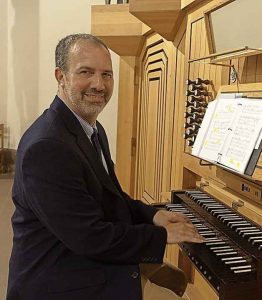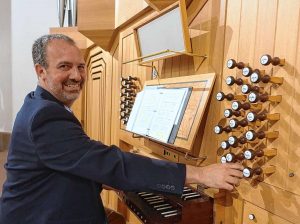Google translation:
Scott Lamlein’s moment of organ art
By Roswitha Frey
Sat, 02. July 2022
Schopfheim
With Widor and American compositions, the organist provided a brilliant start to the organ summer.
The Schopfheim organ summer experienced a brilliant start on Thursday evening. With standing ovations, the numerous listeners celebrated the organist Scott Lamlein from the USA in the Protestant city church, who gave a grandiose concert with works by contemporary American composers and great French organ symphony.
The guest from West Hartford in the US state of Connecticut had last performed at the Schopfheim Organ Festival 15 years ago. Since then, the friendly connection has not broken off, said church music director Christoph Bogon as a welcome. Finally, Lamlein was able to travel across the big pond for his recital planned as early as 2020. In his sheet music luggage, he had confidants of Baroque master Johann Sebastian Bach, but also contemporary music from his American homeland. Impressive in the powerful flow of music, irresistibly dynamic and brilliantly played was Bach’s imagination and fugue in G minor BWV 542 at the beginning.
The works of three US composers, who wrote very catchy things for organ, led to new and different sound realms. In the piece Alborada (Sunrise) by Carson Cooman, Scott Lamlein created a sunrise mood on the Schuke organ wonderfully tone-painting in the colors and register voices, in which the quiet sounds shone more and more strongly.
Cheerful, rhythmically exuberant, full of verve and momentum, Lamlein played the piece “Great Day” by Adolphus Hailstork. The organist developed an enchanting melodic charm in the “Hommage to Gershwin” by Christa Rakich. Smooth and soft in sound, dreamy-desiring and sensitive, Lamlein played this Quodlibet, in which the moving song “Summertime” from Porgy and Bess is varied.
For the crowning main work of the evening, the fifth symphony of Charles-Marie Widor, Lamlein switched to the ideal romantic voit organ on the gallery. How orchestral in sound, differentiated in registration and fascinating in the individual sentence designs he interpreted this great organ symphony was a top-class representation. Rhythmically precise and accentuated in the register effects, trumping in the catthedral great sound, he put the first movement Allegro Vivace in the room. He magically and nuancedly designed the beautiful melody at Allegro cantabile. In the midst of the gripping and exciting sound, the Adagio looked like a meditative island of peace, delicate, quiet, internalized. Lamlein got admirably out the contrasts, nuances and sound effects from this organ symphony, the lyrical as well as the dramatic.
In the final Toccata, he dragged the listeners into a rhythmic pull in a rousing virtuoso manner. Unsurpassed in registration, sonic power and the art of differentiation was this Widor interpretation, with which Lamlein provided a great moment of organ art. “The best Widor I’ve ever heard,” organist colleague Douglas Bruce was as enthusiastic as the audience. On Sunday, Lamlein will play this symphony in Paris in the church of Saint-Sulpice, the former place of work of Widor. With the emotional “Souvenir” by Marcel Dupré as an encore, this fantastic opening evening of the organ summer ended.
Second review:
Google translation:
Organ summer: Scott Lamlein from the USA delivers a tailor-made prelude / Natural change of sound perspectives
Pulled out all the stops: Scott Lamlein opened the Schopfheim Organ Summer with French organ symphony and contemporary American music. Photo: Juergen Scharf
By Juergen Scharf
At the start of the organ summer, the American guest organist Scott Lamlein trumped with Widor’s fifth organ symphony – played in full: an outstanding interpreter of French organ romanticism.
The fact that the concert organist from West Hartford in the US state of Connecticut, who made a guest appearance at the Schopfheim Organ Summer 15 years ago, put Charles-Marie Widor’s major five-movement work on the program in its entirety and did not play excerpts or only the final toccata, as is so often the case, was that Special of this opening concert.
How does Lamlein treat the organ as a substitute for a large orchestra, without misjudging its origin and function? Clearly: not lurid, but articulated intelligently and differentiated. When an equally energetic and sensitive interpreter like him takes on this work and expressively traces not only the loud tutti passages, but especially the quiet parts, one discovers beauty and peculiarities in Widor’s organ symphony.
On the romantic Voit organ, Lamlein succeeded in creating a maximum of colourfulness and moments that captivated the listener and made him win for this French organ music with a sovereign technical overview and a keen sense of tempo design and registration.
Just a few sound perceptions in detail: stormy propulsion in the Allegro first movement, which ends with a full work; great formal arc and calm lingering in the melodic second movement (Cantabile) with its flourishing melody; natural change of sound perspectives from Andantino to Adagio as well as gripping momentum in the Toccata, the most famous “organ bouncer” of all time.
This organ virtuoso exploited the full range of colors of the gallery organ and made it appear in soft fullness and optimal transparency. His sense of sound in the Andantino with the Schwellwerk dynamics is remarkable. Actually, it goes without saying that Lamlein does not take the final movement in a lurid way – no associations with the fairground organ and toccata-like rushing – but rather with a feeling for the sound architecture.
For the pleasantly large number of listeners at the opening concert, this was a special experience.
As the organizer Christoph Bogon emphasized, Scott Lamlein also plays the same work in the Saint-Sulpice church in Paris on the world-famous Cavaillé-Coll organ, where Widor himself worked and for which he composed. But in order not to omit it: the Schopfheim gallery organ also did not owe anything to the demands of this music.
An additional benefit was that Lamlein had brought three pieces from living American composers across the pond. Tone-painterly in Carson Cooman’s “Sunrise”, rhythmically lively, colorful and solemn in Adolphus Hailstork’s “Great Day” and anthemic in Christa Rakich’s “Hommage à Gershwin”, a quodlibet on “Slane”, an old Irish ballad combined with the song “Summer Time”.
Further information: As part of the organ summer, there is an organ concert every Thursday until the end of the month in the evangelical town church. On July 7, at 8 p.m., Heinrich Walther (Heidelberg/Freiburg) will play two important works from the Romantic period: the great sonata on Psalm 94 by Liszt’s pupil Julius Reubke and his own organ transcription of the Symphony in D minor by César-Frank on his 200th birthday anniversary. Admission to the concerts is free, but a reasonable donation is requested. Wearing a mask is at your own discretion.


